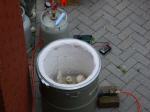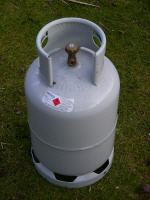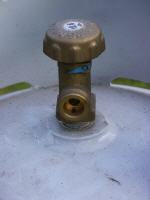|
|
|
 |
 |
 |
 |
SETTING UP THE KILN |
 |
|
|
The kiln should always be fired outdoors.
Appropriate surfaces to put the kiln on are sand or stone. If you fire the kiln on grass you will get a nice burning mark because the bottom gets to hot for that. Also a wooden surface is not recommended. Make sure that the kiln is stable. Having to unload hot wobbling ware with a pair of tongs is very frustrating.
We recommend that you get used to work, check for the ware and unload the kiln from the opposite side of the burner port. Choose the place where you fire the kiln in such a way that you can easily approach the kiln on this side without having to step over the pressure hose in order to get there.
|
|
|
|
|
Your propane tank is filled with liquefied gas that needs to evaporate before it can flow to the burner. This evaporation requires heat in order to take place and so your gas tank is in constant need for some warmth. After a short time of firing you can already see condense on the outside of the tank proving that it is colder that its environment. If the heat requirement of the tank exceeds the heat supply of its environment your tank will get colder and colder and finally it even can freeze. For that reason it is better to place the tank close (0,3 – 0,5 m) to the kiln so it picks up some radiating heat form the kiln. Wind the excess pressure hose around the tank and make sure that it does not touch the kiln. A useful accessory is a coupling that allows you to connect 2 gas tanks to your burner set. Each tank has than to provide only half of the amount of propane.
|
|
|
|
|
Check before firing the condition of the hose. If you see changes in colour, damages or cracks in the hose then you need to replace it immediately.
The year of manufacturing is printed on the hose. In general recommendation is to replace hoses older than 2 years.
A useful accessoiries is a connector hose, which allows you to connect two gas tanks to you burner. This way each tank only has to provide half of the gas volume making it a bit easier for the tanks. Especially in colder weather condition or multiple firing sessions after another.
|
|
|
Printable Version
|
|




